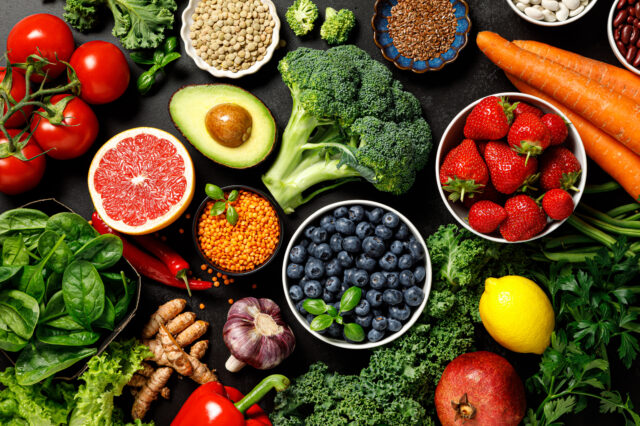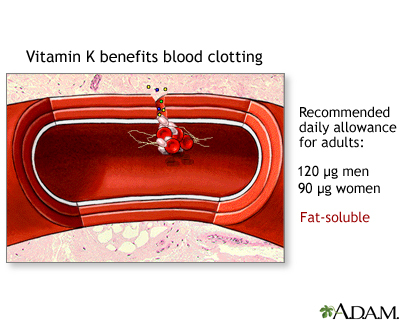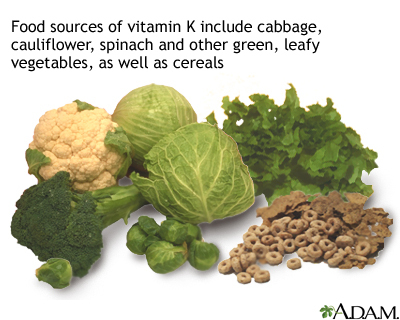What's so great about fruits and vegetables?
For generations, we have known that fruits and vegetables are good for our health. Multiple studies show time and again that we live longer when we eat more…

Update your location to show providers, locations, and services closest to you.
Vitamin K is a fat-soluble vitamin. Your body stores vitamin K in the liver and other body tissues, including the brain, heart, pancreas, and bone.
Phylloquinone; K1; Menaquinone; K2; Menadione; K3
Vitamin K is known as the clotting vitamin. Without it, blood would not clot. Some studies suggest that it helps maintain strong bones in older adults.
The best way to get the daily requirement of vitamin K is by eating food sources. Vitamin K is found in the following foods:
Vitamin K is also made by the bacteria in the lower intestinal tract.
Vitamin K deficiency is very rare. It occurs when the body can't properly absorb the vitamin from the intestinal tract. Vitamin K deficiency can also occur after long-term treatment with antibiotics.
People with vitamin K deficiency are often more likely to have bruising and bleeding.
Keep in mind that:
Ask your health care provider if you need to monitor your intake of vitamin K containing foods and how much you can eat.
Recommendations for vitamin K, as well as other nutrients, are provided in the Dietary Reference Intakes (DRIs) developed by the Food and Nutrition Board at the National Academies of Sciences, Engineering, and Medicine. DRI is a term for a set of reference intakes that are used to plan and assess the nutrient intakes of healthy people. These values, which vary by age and sex, include:
Recommended Dietary Allowance (RDA): The average daily level of intake that is enough to meet the nutrient needs of nearly all (97% to 98%) healthy people. An RDA is an intake level based on scientific research evidence.
Adequate Intake (AI): This level is established when there is not enough scientific research evidence to develop an RDA. It is set at a level that is thought to ensure enough nutrition.
Dietary reference intakes for vitamin K:
Infants (AI)
Children (AI)
Adolescents and adults (AI)


Markell M, Siddiqi HA. Vitamins and trace elements. In: McPherson RA, Pincus MR, eds. Henry's Clinical Diagnosis and Management by Laboratory Methods. 24th ed. Philadelphia, PA: Elsevier; 2022:chap 27.
Mason JB, Booth SL. Vitamins, trace minerals, and other micronutrients. In: Goldman L, Schafer AI, eds. Goldman-Cecil Medicine. 26th ed. Philadelphia, PA: Elsevier; 2020:chap 205.
For generations, we have known that fruits and vegetables are good for our health. Multiple studies show time and again that we live longer when we eat more…

Vitamin K is a key substance our bodies need to clot blood. For adults, vitamin K deficiency is not a major concern because gut bacteria help to ensure our bodies have enough. But newborn babies,...
Vitamin D plays a big role in keeping bones strong and helping the body absorb calcium … and not having enough of it can lead to a whole slew of ailments. Vitamin D deficiency can increase the risk...
In a nation where half of all adults pop dietary supplements, only...